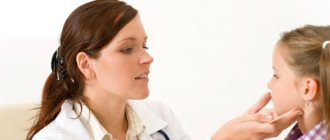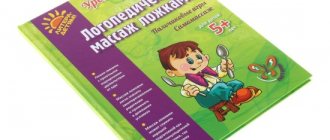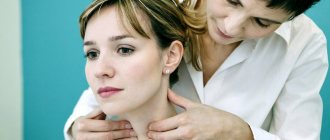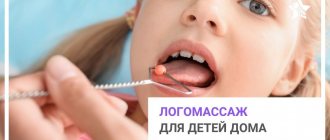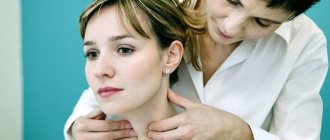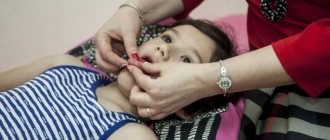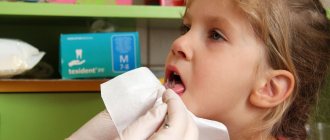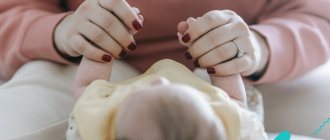Speech therapy massage
About the speech therapy massage method
With the help of speech therapy massage, you can correct and completely eliminate serious speech disorders, ranging from stuttering to partial and even complete loss of speech.
The method helps well to correct speech, its emotional coloring, and the correct pronunciation of sounds. Speech therapy massage consists of a set of individually selected exercises that affect the muscles, nerve endings and other tissues of the speech apparatus. Special techniques help relax the facial muscles, normalize muscle tone and sound pronunciation.
Speech therapy massage is performed already at the 3rd month, when the newborn begins to walk. During this period, to stimulate speech skills, it is recommended to do a finger massage. If by the age of two the child has not begun to speak clearly, this is a good reason to contact a neurologist and speech therapist. But it is not too late to start speech therapy massage even in older children. Starting from 3 years old, probe speech therapy massage can be performed. It is especially important to sign up for a speech therapy massage at the age of 5-6: correct speech will help the child adapt more easily to school.
At the Research Institute of Neurology and Pediatrics “Indigo Children”, several types of speech therapy massage are used:
- classic manual;
- point (active acupuncture zones associated with speech centers in the brain are stimulated);
- probe speech therapy massage (carried out using professional instruments that allow targeted stimulation of the necessary areas of the articulatory apparatus).
Indications for speech therapy massage
Many speech disorders can be corrected with the help of speech therapy massage (dysarthria, rhinolalia, aphasia, etc.), even if other pedagogical correction techniques are powerless. For delayed speech and mental development, impaired sound reproduction, stuttering, lack of emotionality in speech and other problems, the method of probe speech therapy massage is optimal. For example, with dysarthria (impaired pronunciation of words, confused speech, with a nasal pronunciation, “porridge in the mouth”), speech therapy massage helps to activate the muscles of the speech apparatus, form the correct swallowing reflex, coordinate the movements of the tongue, and stimulate the transmission of impulses to the cerebral cortex. The method gives good results with profuse salivation (salivation).
How does the speech therapy massage procedure work?
Speech therapy massage begins with a general facial massage, stroking and rubbing the forehead, cheeks, lips, etc. After the facial muscles are warmed up, proceed to massage problem areas. One of the main points is speech therapy massage for the tongue, since this is the most important articulatory organ. A probe for speech therapy massage is most often used in the tongue area. Probes for speech therapy massage are sterile and do not have sharp edges.
The entire procedure can last from 15 to 30 minutes, depending on the tasks and the degree of speech impairment. Treatment is carried out in courses of 10-15 sessions. Between courses take breaks of up to 2-3 months (depending on the clinical picture) to consolidate the achieved results.
At the Research Institute of Neurology and Pediatrics “Indigo Children”, speech therapy massage is performed by an experienced speech therapist. It is better if the mother leaves the baby alone with the specialist. As practice shows, this allows you to more effectively engage the child.
The Indigo Children Center provides everything to ensure that speech therapy massage brings pleasure to the child. Classes are conducted in a playful way, in a separate equipped room. It is important to relieve psychological stress and ensure good results from the exercises.
During speech therapy massage, techniques such as fairy tale therapy are used. Fairytale therapy techniques are especially good for working with autistic children, as they help to engage the child in dialogue.
Another technique, logorhythmics, is good for children with undeveloped speech skills. Simple rhymes and rhythmic texts, combined with movements, work to make the child want to participate in speech.
general information
The main purpose of massage for stuttering is a mechanical effect on the condition of muscles, nerves, and blood vessels. Conducted by a speech therapist, probes are used if necessary.
Logomassage is part of complex therapy. In other words, it cannot be a panacea, but it can improve the child’s condition.
Children begin to stutter for various reasons. Scientists believe that it’s all about a combination of genetic and neurological factors. A predisposing factor is muscle hypertonicity. In adults, the disease appears after concussion, head injury, or stroke.
Massage can be used both in a special institution and at home. But before using it, doctors check the patient. The procedure has contraindications. The exposure is carried out in courses with a short break between them.
Massage helps to relax the muscles - vocal, articulatory, regulating the breathing process. The child’s mental state normalizes. Metabolism increases and blood circulation improves. Against this background, there is a decrease in the manifestations of stuttering.
The benefits of massage for stuttering
A special massage of the head, cervical region, collar area, back, chest and shoulders has a positive effect on articulation. The benefits of this procedure are visible after several sessions, but sometimes 1-2 courses of treatment are required.
The advantages of massage for logoneurosis are:
- activation of metabolic processes in the body;
- increase or decrease in muscle tone;
- improving blood circulation;
- increased metabolism;
- formation of correct speech skills;
- prevention of disease relapse;
- complete elimination or minimization of speech defects.
The procedure has no contraindications, and having mastered the correct massage technique, parents will be able to do it to their child at home.
Self-massage
A specialist can teach children self-massage skills. This doesn't require much effort. Preschoolers are taught in front of a mirror, shown an example of an action and asked to repeat:
- The first exercise is to gently stroke your cheeks with your palms, working from your nose to your ears. You can stroke the head, going lower from the hair.
- The second exercise is to run your fingers with pressure from the middle of the forehead to the temples, as if drawing paths. You can draw a “Christmas tree”.
- The third exercise is tapping the forehead and cheeks with pads. There may be more exercises. The complex is compiled by a speech therapist based on the individual characteristics of the child.
Krupenchuk has her own method. She improved the Dyakova complex. Regular spoons are used for massage - this is perceived more positively by the child.
The process can be combined with games. In this case, it will be more interesting for children to complete the tasks of the speech therapist. As an incentive, you can give a sticker or the opportunity to choose a game.
Point impact
When a child begins to stutter, acupressure is indicated. Rules for manipulation:
- light touches, without strong pressure;
- impact on one point takes 2–3 seconds, no more;
- more than 4 active points are not worked on during a session;
- the number of segments worked increases by 4 points with each subsequent session;
- massage is not performed if the child is irritated or crying - he should feel comfortable;
- manipulations are carried out with clean, warm, dry hands;
- The massage begins an hour after eating and the baby is not allowed to eat for another hour after the procedure; water at room temperature is required afterwards.
Acupressure is often combined with segmental techniques. Having previously relaxed the tense muscle, they begin to apply pressure to the points. The first session lasts 5 minutes. Gradually the time is increased to 20 minutes.
During the massage, the specialist monitors the patient’s condition. If he feels bad or nervous, the massage is stopped. If manipulations are carried out on school-age children, they are suspended from school for 1–2 weeks and social communication is limited. The complex provides classes with a speech therapist and homework assignments. 2 hours are allotted for this.
Scheme of acupressure facial massage
The procedure is performed using the fingertips. The patient is in a supine position or sitting in a comfortable chair with a high back. The pads of the index fingers are placed in the center of the forehead, drawn to the sides above the eyebrows, moving towards the temples. The manipulation is performed 2–3 times. Next, the fingers are placed on both sides of the bridge of the nose, opposite the inner corners of the eyes. Lightly press on the points and hold for 2-3 seconds.
Then they move under the eyes, along the bones to the temples, rise, pass under the eyebrows and return to the starting point. Make 3-5 circular movements back and forth.
Light pinch movements along the eyebrows begin from the starting point. From the starting point on the bridge of the nose, make several movements towards the wings of the nose, pressing on them for 2-3 seconds.
Move on to the ears. Use your index finger and thumb to grab your earlobes and massage them with gentle circular movements. Press on the point under the lobes. They go down the neck along the lymph nodes. There is no pressure on them. The intake stimulates the outflow of lymph and strengthens the laryngeal muscles. Next, the collarbone area is worked on. They rise up the larynx. Grasping it with three fingers, perform rhythmic movements, stretching the skin slightly to the sides. To increase efficiency, the patient is asked to recite vowels.
Next move on to the scalp. The massage therapist's hand is positioned so that four fingers cover the frontal lobe, and the thumb rests on or behind the crown. Using gentle progressive movements, without pressure, massage the head. Then they place the fingers of both hands in the area of the fontanel and, without pressure, work along the parting, gradually moving to the occipital part. In the area of the first cervical vertebra, place the pads of the index fingers on the active points. They are located in the depressions at a distance from the spine, about 2 cm. Hold your fingers on them for 2-3 seconds, then massage in a circular motion 3 times forward and 3 times back. When performing them, they descend along the neck to the collar area. Then they work the line in the opposite direction using the pads of their thumbs. Move to the area behind the ears and work it with circular movements.
The massage course lasts 2–3 weeks without a break. After 20 days it is repeated.
After complete recovery, it is advisable to carry out the course for preventive purposes 3-4 times a year.
Segmental massage for speech defects: technique
Segmental effects on the baby’s body have a beneficial effect on the entire body. Before the manipulation, the child sits in a position that is comfortable for him and tries to relax. He needs to stretch his arms along his body and completely relax his legs. The massage can also be carried out when the baby is sitting in a chair, with the head slightly tilted on a special soft headrest.
The specialist performs segmental massage while standing behind the patient’s head. During the procedure, several basic techniques are used: rubbing, kneading, stroking, tapping, vibration, alternating pressure.
Causes of orthopedic orofacial disorders
There is no known single known cause of orofacial myological problems in children. They can be caused by several factors:
- Blockage of the nasal passages due to the size of the tonsils or allergies. When the nasal passages are blocked, children can breathe through their mouth.
- Anything that causes the tongue to move when at rest or makes it difficult to keep the lips at rest.
- Sucking and chewing habits over 3 years of age.
- Sucking thumbs, pacifiers, or blankets
- Habit of biting nails
- Habitual biting of the cheek or lip
- Chewing clothing collars
- Enlarged tonsils or adenoids
- Nasal congestion
- Narrow or vaulted palate
- Big tongue
- Allergies that limit airway patency
- Structural or physiological abnormalities, such as a tongue tie
- Neurological or developmental abnormalities
- Hereditary predisposition
Common orthopedic orofacial disorders in children
Contraindications for use
Any massage techniques activate brain centers, which can cause a deterioration in the patient’s condition in the presence of additional pathologies, chronic and infectious diseases. Contraindications to massage manipulations:
- pneumonia, viral diseases, otitis media, tonsillitis;
- blood diseases;
- oncology;
- skin damage;
- allergic skin rashes;
- gag reflex;
- temperature;
- inflammation of the lymph nodes.
Basic Techniques
Each session begins with stroking. It is alternated with other techniques, but it is always completed with this technique. It can be superficial - the brush lightly touches the skin, gently and affectionately, with a deep grasping movement it affects the skin receptors and the nervous system. The palm is pressed firmly against the area and glides along the anatomical contours.
Stroking the “rake” - the fingers are spread wide, the pads actively massage the area of pressure. Performed in a circle, zigzag, wavy.
Rubbing involves applying strong pressure to a small area of muscle. It is performed both with the fingertips and the entire palm. The degree of impact is determined individually. Directions are spiral and straight.
Kneading - the fabric is gently rubbed, squeezed, compressed. Used in a small area. Perform with fingertips; in rare cases, pinching is allowed.
Vibration is created by lightly tapping your fingers on the surface of the muscles. Used in areas with minimal fat and where cranial nerves exit. Firm pressure allows you to target biologically active points (BAP).
The help from speech therapy massage will only be felt if the sessions are regular and the specialist is highly qualified. The choice of techniques depends on muscle tone and pathological features.
